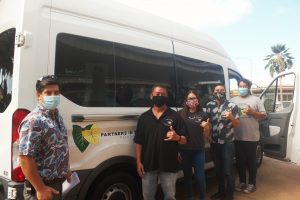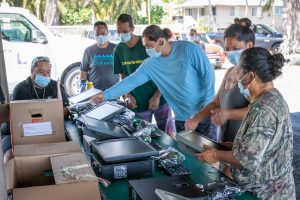The Broadband Hui: Bridging the digital divide
Posted on Mar 1, 2021 in Capitol Connection, FeaturedIt would be an understatement to say COVID-19 has changed everything — from work to school to travel to family bubbles. Who knew we would be online nearly 24/7, navigating websites, and Zooming while trying to stay safe and survive? The pandemic has shown us gaps and community needs we didn’t know were there. But it also has spurred people, such as those in the Broadband Hui — a cross-section of some 250 public and private stakeholders — to realize that the state’s digital future depends on action now. “The Broadband Hui has helped galvanize the community voice,” said state broadband strategy officer Burt Lum. “What the pandemic helped everyone realize is that we’ve got to have the internet connection, the hardware, the digital literacy and the know-how to be full participants. If you don’t have ‘digital equity,’ you’re still not there.” This equity extends communitywide — whether you’re a student learning online, a person applying for unemployment or a new job, or someone talking to a doctor.

Hawai‘i Kids Can, Kamehameha School, Partners in Development and Kamaile Academy deploy one of the WiFi on Wheels buses in Wai‘anae.
Because this digital connection became crucial in the pandemic, the federal government has provided for expansion of infrastructure devoted to delivering better internet services. However, Lum says other funds are needed to train and equip people to take advantage of these connections. “Because of the pandemic, we’ve had a multitude of groups who recognize our ‘digital divide’ and are providing ‘last-mile solutions.’” Lum named several community groups who responded to the call to help, such as the Kuauli Digital Opportunities Initiative, which got computer equipment into the hands of needy families or WiFi on Wheels, which distributed mobile WiFi buses to rural areas. HOPE Services Telehealth Program used CARES Act funds to purchase iPads and wireless connections so field workers could check on homeless communities on Hawai‘i island. Other projects in the works will provide a community network for Pu‘uhonua o Wai‘anae, and another $30 million from the Consolidated Appropriations Act 2021 is earmarked for the Department of Hawaiian Homelands.
Bills have also been introduced in the Legislature to establish a Broadband and Digital Equity Office to coordinate broadband development and digital equity programs. The current Broadband Hui is a cross-section of some 250 public and private stakeholders who came together to help. “We’re looking to establish a lasting presence inside government — a community voice to drive broadband equity,” he explained. “It’s part of the foundation, like fiber optic infrastructure. We have to do this now with the momentum to make it happen.”
